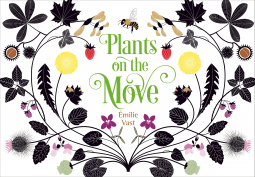Early Book Review: A Flower is a Friend by Frieda Wishinsky, Karen Patkau
Early Book Review: Tiny and Wild: Build a Small-Scale Meadow Anywhere by Graham Laird Gardner
Early Book Review: Amazing Plants of the World by Stepanka Sekaninova
Book Review: Plants on the Move by Émilie Vast
Early Book Review: 100 Plants to Feed the Monarch: Create a Healthy Habitat to Sustain North America's Most Beloved Butterfly by The Xerces Society
100 Plants to Feed the Monarch: Create a Healthy Habitat to Sustain North America's Most Beloved Butterfly by The Xerces Society is currently scheduled for release on April 13 2021. The plight of the monarch butterfly has captured public attention and sparked widespread interest in helping to save their dwindling populations. In this in-depth portrait of the monarch butterfly—covering its life cycle, its remarkable relationship with milkweed, its extraordinary migration, and the threats it now faces due to habitat loss and climate change—detailed instructions on how to design and create monarch-friendly landscapes are enriched by guidance on observing and understanding butterfly behavior and habits. Following the model of their previous best-selling book, 100 Plants to Feed the Bees, the Xerces Society provides at-a-glance profiles of the plant species that provide monarchs with nourishment. The plants, which are all commercially available, range from dozens of species of milkweed—the only food of monarch caterpillars—to numerous flowering plants, shrubs, and trees that provide nectar for the adult butterfly, including those that bloom in late season and sustain monarchs in their great migration. Gorgeous photographs of monarchs and plants, plus illustrations, maps, and garden plans, make this a visually engaging guide.
Early Book Review: Grow Your Own Tea: The Complete Guide to Cultivating, Harvesting, and Preparing by Christine Parks; Susan M. Walcott
Early Book Review: Northeast Medicinal Plants: Identify, Harvest, and Use 111 Wild Herbs for Health and Wellness by Liz Neves
Early Book Review: Something Wonderful by Matt Ritter, Nayl Gonzalez
Book Review: Grow in the Dark: How to Choose and Care for Low-Light Houseplants by Lisa Eldred Steinkopf
Book Review: The Illustrated Herbiary: Guidance and Rituals from 36 Bewitching Botanicals by Maia Toll, Katherine O'Hara
Book Review: Plantopedia: A Celebration of Nature's Greatest Show-Off by Adrienne Barman
Early Book Review: Gardening Under Lights: The Complete Guide for Indoor Growers by Leslie F Halleck
 Gardening Under Lights: The Complete Guide for Indoor Growers by Leslie F Halleck is currently scheduled for release on July 11 2018. This book is a resource that gives information on just about everything a gardener or hobbyist needs to know to garden indoors. Part One of the book starts with the basics of photosynthesis, the science of light, and how to accurately measure how much light a plant needs. Part Two gives an overview of the most up-to-date tools and gear available. Parts Three and Four offer tips and tools for growing popular ornamental and edible plants independent of the constraints of volatile outdoor conditions.
Gardening Under Lights: The Complete Guide for Indoor Growers by Leslie F Halleck is currently scheduled for release on July 11 2018. This book is a resource that gives information on just about everything a gardener or hobbyist needs to know to garden indoors. Part One of the book starts with the basics of photosynthesis, the science of light, and how to accurately measure how much light a plant needs. Part Two gives an overview of the most up-to-date tools and gear available. Parts Three and Four offer tips and tools for growing popular ornamental and edible plants independent of the constraints of volatile outdoor conditions. Book Review: Ninja Plants: Survival and Adaptation in the Plant World by Wiley Blevins
 Ninja Plants: Survival and Adaptation in the Plant World is a well-written and organized book that informs and entertains. I have always been fascinated by plants, the more unusual the better. This book feed that curiosity and taught be a few new things along the way. I think it is fairly text heavy, but there are some stunning images through out the pages to break up the information. The text and images were interesting and informative- holding my interest and exploring the wide variety of plants around the world that have adapted in dangerous and amazing ways to survive. I really enjoyed the conclusion, and think it a valuable read.
Ninja Plants: Survival and Adaptation in the Plant World is a well-written and organized book that informs and entertains. I have always been fascinated by plants, the more unusual the better. This book feed that curiosity and taught be a few new things along the way. I think it is fairly text heavy, but there are some stunning images through out the pages to break up the information. The text and images were interesting and informative- holding my interest and exploring the wide variety of plants around the world that have adapted in dangerous and amazing ways to survive. I really enjoyed the conclusion, and think it a valuable read. 












